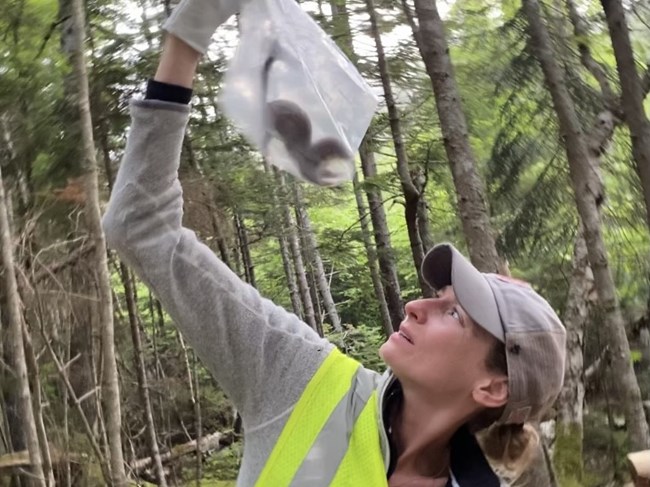Last updated: June 20, 2024
Article
Research Brief: Small Mammals and their response to Disturbance

Ellie Jackson/Schoodic Institute
Red squirrels, chipmunks, voles, mice, and other small mammals are part of Acadia’s community of wildlife. Because small mammals are important prey for other animals, and help disperse seeds of trees and other plants, they are recognized as indicators of ecological change.
Encounters between these creatures and park visitors can be a source of delight for the humans but may be stressful for certain animals. If encounters are frequent enough, the animals may avoid areas with lots of people. Visitors also affect wildlife by damaging habitat.
Managers offset negative impacts of recreational use by restoring degraded areas (such as on the summit of Cadillac and other mountains), removing invasive species that can be spread via visitor shoes and clothing, and closing trails to protect animals such as peregrine falcons. Yet management activities, too, can be a source of disturbance to wildlife.
Not much is known about these interactions in Acadia.

Ellie Jackson/Schoodic Institute
"Ecological interactions are among the wonders that draw people to Acadia and to wildlife,” said Bik Wheeler, wildlife biologist with Acadia National Park. “To effectively manage wildlife in the park it is critical to understand both the physical presence of wildlife and ecological interactions, including those with humans."
Second Century Stewardship Fellow Dr. Brittany Slabach, Professor of Biology and the Emily and Mitch Rales Chair in Ecology at College of the Atlantic, studies how landscape ecology and park management affect biodiversity of small mammals. In research elsewhere, she has found that even with diverse habitats, small mammals tend to occur in isolated areas away from locations frequented by visitors and undergoing habitat restoration.
Using live traps and wildlife cameras, Slabach is conducting surveys of small mammals at sites in Acadia experiencing different types of disturbance. She traps and releases animals from summer through winter to capture seasonal variation.
June 2024 Research Update
We had a busy and successful first season in Acadia! Our team of students completed a camera study that produced more than 60,000 photographs to investigate how recreation influences mammal presence and occupancy in the park. We documented over seventeen different animal species on Schoodic Peninsula trails, from deer mice to moose, and how their use of trails varied by season.
Building on last year’s data, we have implemented a baited camera study this season. We know mustelids (weasels) live on Schoodic Peninsula but we don’t have a lot of information about their presence, as there are not many photographs, such as iNaturalist observations. Using a scent lure can help to increase captures of these cryptic species. Cameras were deployed in June and will be monitored through August. We recently did our first rebaiting session and, while we did not capture a mustelid, we observed a beautiful bull moose!
In addition to our camera studies, we implemented two different studies both investigating the effects of disturbance on small mammal communities. Our work on Schoodic Peninsula focused on how historical landscape disturbance (e.g., logging) has shaped current small mammal communities. We captured six different species of small mammals and observed interesting patterns of biodiversity between historically disturbed and old-growth forests. This is a long-term project, and we are interested to continue investigating relationships between different habitats, and the potential competitive interactions between species. Our small mammal work also took us to Sargent Mountain on Mount Desert Island last summer. We are investigating the small mammal communities that call the mountains home. With the vegetation restoration effort underway on Sargent and Penobscot Mountains, we are also interested in the potential interaction between small mammals and the restoration project. We trapped two species, deer mice and eastern meadow voles, on Sargent Mountain in 2023. We will soon be summiting mountains again to trap small mammals, and you may see us and our trap boxes out on the landscape. We will be working on both Sargent and Pemetic Mountains. Pemetic Mountain is not currently part of the soil restoration, therefore it will provide an important comparison to restored summits. We will also be deploying collars to understand small mammal home range, and potential interactions with seeded vegetation plots on summits.
You can follow along with our work on Instagram (@littleboxproject). Happy Hiking!

Ellie Jackson/Schoodic Institute
